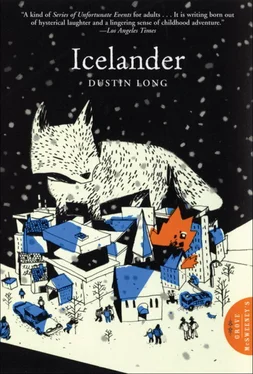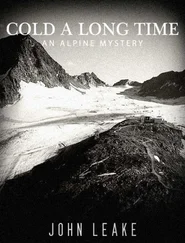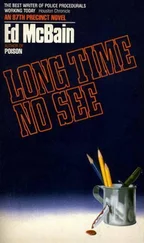This supposed affectionate attitude toward the man did little to deter Our Heroine’s much publicized feud with Valison, in later years, over whether or not he had the moral right to novelize her mother’s memoirs. Art, of course, creates its own morality.
See Volume 5 of The Memoirs of Emily Bean .
The Vanaheimic word for “steampool.”
See the first volume of the Memoirs for a fuller account of these events.
For the record, Our Heroine’s own trivial academic interests—as detailed in The Greenland Gravestone Robberies (Volume 12 of the Memoirs )—include: Iceland’s enforced linguistic purity, the patronymic tradition, and the genetic purity requirement of its citizenry—the whole idea of “authenticity,” as she phrases it, and just what it means to be a “real” Icelander.
A passion shared by the Master.
Despite Our Heroine’s arrogant assumption, Constance Lingus did not mention her in that morning’s article concerning the murder.
See Volume 8 of The Memoirs of Emily Bean , Experts Texperts .
Considering that Magnus Valison was killed by belt-strangulation—and only shortly after the events that this novel describes—I find such references to belts to be in exceedingly poor taste.
Sixteenth-century Icelander who is purported to have discovered an underground realm that may or may not have been connected to Vanaheim. See Volume 2 of the Memoirs , The Case of the Backwards Bookshelf , for the full details of the events referred to here.
Such loose usage of the term “memoirs” has been a common point of confusion among many readers of Valison’s novels. Some have even labored under the misapprehension that Emily Bean was an entirely fictitious character and that the diaries upon which Valison based his most famous series were merely created by him as a dramatic device. This is a perfectly understandable assumption, as many of the Master’s earlier novels employed such techniques as fictitious editors and imaginary source material. The fact remains, however, that Emily Bean was indeed a real woman, that she recorded all of her adventures in a multivolume field diary, and that Magnus Valison used that diary as the basis for a series of twelve novels that he published in the years following her death and which he titled The Memoirs of Emily Bean . Now, as to the simpler question of how closely his novels adhere to their source material, one can only speculate. The Master undoubtedly added a great degree of dramatic tension and linguistic artistry that would have otherwise been lacking, yet he also always insisted that everything in the Memoirs was true. Of course, he also claimed that Art was its own Truth, so this previous statement may not be as straightforward as it seems. Yet in basic outline, at the least, the Memoirs are based in fact.
A pointless argument, it seems to me, since as the Master pointed out in an early essay on the Kalevala, “Art is justified by its own morality.”
Magnus Valison’s exact feelings on the issue of Vanaheim’s sovereignty are difficult to discern. Though Gerd was a featured antagonist in a full fourth of the twelve volumes of the Memoirs (implying at least some sympathy on Valison’s part with her Icelandic detractors), Valison’s views as expressed in his nonfiction works are unabashedly pro-Vanaheim, often evincing the opinion that topside Iceland—having endured the colonial yoke of Denmark for an even longer term than his own native Ghana—could not be forgiven for assuming the oppressor’s role itself. In some instances, he even seems to advocate violent overthrow. As he writes in A Sodomite Cookbook , “We await the day that Vanaheim, like an unruly footnote, will rise to overwhelm the would-be master text of topside Iceland.”
See Volume 3 of the Memoirs .
An apt choice of cliché, for once, compared to all of the “derisive snorts” and “malicious grins” found elsewhere in the text. The mythological character from whom Surt derived his nomme de crime is neither one of the Aesir (the central deities of mainstream Norse theology) nor one of the Vanir (the central deities of Vanatru theology). Rather, he is a singular primal being from the fiery land of Muspellheim (somewhere south of the inhabited world), where he silently awaits the advent of Ragnarok, the day on which he will reforge his flaming sword and with it fell the dead hollow form of Yggdrasil that new life might grow in its place.
A common topic of debate among Valison scholars is whether or not genius was the only aspect of Surt that Emily Bean admired.
With some minor differences of detail, the “case” that follows apparently corresponds to Volume 10 of the Memoirs , Et in Orcadia Ego .
The constant shifting between multiple narrators in this portion of the novel renders the chronology somewhat unclear, but internal evidence would suggest that the sections narrated by Nathan occur during the summer of 1998 while all other sections occur—like the rest of the text—on Bean Day of 2001 (except where explicitly noted otherwise). I was indoors for most of this day, myself, and thus unfortunately can offer little in the way of first-hand corroboration for any of this.
Though Our Heroine otherwise seems to be the narrative focalizer of the novel as a whole, her first-person narration, here, seems relatively sparse in comparison to the more fully developed sections devoted to Nathan, Wible & Pacheco, and Blaise Duplain. While Part One (Prelude) appears to be perhaps an attempt to evoke the Valisonian voice while simultaneously resisting submission to the standard tropes of his more “mystery” oriented narratives, Part Two (Ludo) seems to set the reader adrift in a sea of narrators while Our Heroine struggles simply to find a voice that she can call her own.
One of the only extant pieces of Shirley MacGuffin’s fiction. More on this later.
The Master’s description of a similar scene in The Fox in the Snow ( The Memoirs of Emily Bean Vol. 4) as “the light of a green sun whose orb was diffused across the entirety of the sky” takes into literary account the fact that the primary deity of the Vanatru religion is Frey—a sun god—and not the more popular thunder god apparently favored by the author of the current narrative.
L’anse aux Meadows is the site of an early Viking settlement in Newfoundland from circa 1000 A.D. The details of the strange crimes that occurred there in 1980 can be found in Would as Leif , the aforementioned seventh volume of Valison’s The Memoirs of Emily Bean .
Considering Hubert Jorgen’s status as the most ingenious library scientist of modern times, all facets of his organizational style should have been recorded in detail. Though horizontally the book may have been found between the two volumes mentioned, perhaps more relevant information might have been revealed if the investigators had taken note of the fact that the book’s vertical neighbors were, say, Vladimir Nabokov and Elizabeth Peters. Not that I have any way of knowing. As it is, one can only speculate what valuable data was lost in their clumsy account.
Читать дальше












